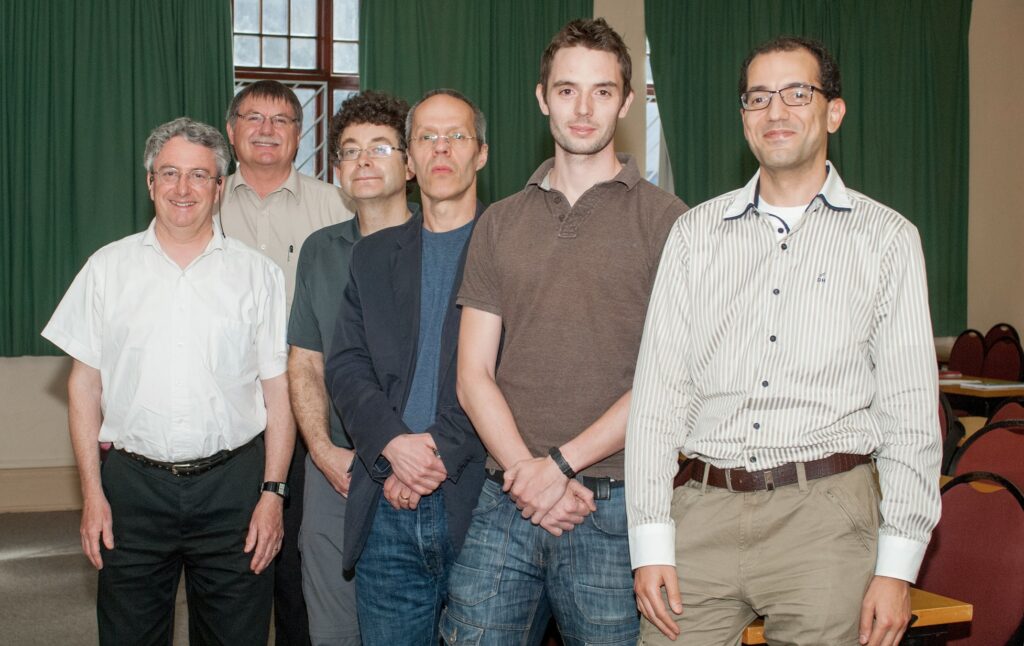22 April 2014, 14:00 – 16:45
The talks will be held in the main lecture room at AIMS South Africa.
14:00-14:35 John King, University of Nottingham
Title: Multiscale modelling in systems biology and industrial mathematics
Abstract: Following a brief overview of some of the applied-mathematics research at the University of Nottingham, specific examples of applications will be described, involving discrete-to-continuum limits (and exponential asymptotics) and thin-film flows (high-order partial differential equations), in which the relevant mathematical formulations can be expressed in concise terms.View photos
14:40-15:15 Jan Nordström, University of Lingkoping
Title: High Order Finite Difference Approximations of Multi-physics Problems
Abstract: Great progress have been made for high order finite difference methods during the last 20 years. It is now rather straightforward to construct stable and high order accurate multi-block finite difference schemes in a building-block-like manner. In this talk we will discus new developments, new extensions, new fields of applications, share experience on the full scale use of the technique, and speculate about future trends. We present the theory by using simple model problems, and exemplify with complex multi-physics applications. First we walk through the basic technique for a simple model problem where all the ingredients such as well-posedness, summation-by-parts operators, penalty techniques for boundary and interface conditions, and the energy method are explained. Next, we discuss the application of the theory to coupling techniques for conjugate heat transfer, earthquake simulations, fluid- solid interaction and simulation of potential propagation in neuronal branches. Finally we discuss new time-integration procedures, new boundary conditions for the Navier-Stokes equations and a new variance reduction technique for stochastic partial differential equations.
15:30-16:05 Nick Hale, University of Oxford (currently a postdoc at SU)
Title: An algorithm for the convolution of Legendre expansions
Abstract: Convolution is widely-used and fundamental mathematical operation in signal processing, statistics, and PDE theory. Unfortunately the CONV() method in Chebfun [3] for convolving two chebfun objects has long been one of the most disappointingly slow features of the project. In this talk we will present a new algorithm [2], which shows performance gains on the order of a factor 100. The key components of the new algorithm are:
* a convolution theorem for Legendre polynomials
* recurrence relations satisfied by spherical Bessel functions
* recent developments in fast Chebyshev-Legendre transforms [1]
Time-permitting, we shall end with an application from statistics, using the fact that the probability distribution of the sum of two independent random variables is the convolution of their individual distributions.
[1] N. Hale and A. Townsend, “A fast, simple, and stable Chebyshev-Legendre transform using an asymptotic formula”, SISC, Vol. 36, No. 1, pp. A148-A167, 2014.
[2] N. Hale and A. Townsend, “An algorithm for the convolution of Legendre series”, SISC (to appear).
[3] L.N. Trefethen et al., Chebfun V4, www.chebfun.org/
16:10-16:45 Willy Hereman, Colorado School of Mines
Title: Symbolic Computation of Scaling Invariant Lax Pairs in Operator Form for Integrable Systems
Abstract: Peter Lax discovered in 1968 that nonlinear partial differential equations (PDEs) that describe solitons have a remarkable property: they can be replaced by a compatible system of linear PDEs (called a Lax pair) in an auxiliary eigenfunction. The compatibility only holds if the original nonlinear PDE is satisfied. Nonlinear PDEs with that property are called completely integrable.
Based on scaling symmetry properties, a direct method to compute Lax pairs in operator form for completely integrable systems will be presented.
By splitting the determining equations for the Lax pair into kinematic and dynamical constraints, the problem can be reduced to solving nonlinear algebraic equations.
The method will be illustrated with well-known examples from soliton theory and applied to a three parameter class of fifth-order KdV-like evolution equations.

